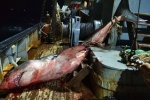Nov 2020: Great White Shark Caught in Kuril Islands
H. Nickel, Shark Year Magazine, 21. January 2021 In early November 2020, news broke out that Russian fishermen caught a large shark in the Kuril archipelago. The available information is very vague. But according to the source, the catch was made in the waters of Shikotan (an island in the southern Kurils). They shared photos
Environmental DNA can detect bull sharks across a dynamic deltaic interface
Swimming against the flow—Environmental DNA can detect bull sharks (Carcharhinus leucas) across a dynamic deltaic interface James Marcus Drymon, Katherine E. Schweiss, Emily A. Seubert, Ryan N. Lehman, Toby S. Daly‐Engel, Mariah Pfleger, Nicole M. Phillips ABSTRACT: Human activities in coastal areas are accelerating ecosystem changes at an unprecedented pace, resulting in habitat loss, hydrological
Study estimates 200-plus white sharks breed each year
News Release The University of Queensland 23 December 2020 — — — — — — — — — — — A study on the vulnerable white shark has shown that approximately 206 to 252 sharks breed on Australia’s east coast each year. The joint study involving The University of Queensland, NSW Department of Primary Industries and Stellenbosch University in South Africa
Age, growth and reproductive biology of Trygonorrhina fasciata and Dentiraja australis
Age, growth and reproductive biology of two endemic demersal bycatch elasmobranchs: Trygonorrhina fasciata and Dentiraja australis (Chondrichthyes: Rhinopristiformes, Rajiformes) from Eastern Australia Marcelo Reis, Will F. Figueira ABSTRACT: Bottom-dwelling elasmobranchs, such as guitarfishes, skates and stingrays are highly susceptible species to bycatch due to the overlap between their distribution and area of fishing operations. Catch
Effective number of white shark breeders is stable over four successive years in the population adjacent to eastern Australia and New Zealand
Effective number of white shark (Carcharodon carcharias, Linnaeus) breeders is stable over four successive years in the population adjacent to eastern Australia and New Zealand Danielle Davenport, Paul Butcher, Sara Andreotti, Conrad Matthee, Andrew Jones, Jennifer Ovenden ABSTRACT: Population size is a central parameter for conservation; however, monitoring abundance is often problematic for threatened marine





